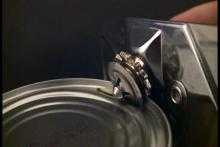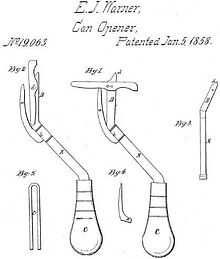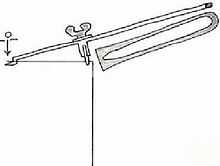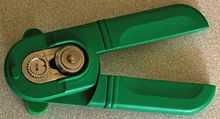Can opener

A can opener (in North American English and Australian English) or tin opener (in British and Commonwealth English) is a device used to open tin cans (metal cans). Although preservation of food using tin cans had been practiced since at least 1772 in the Netherlands, the first can openers were patented only in 1855 in England and in 1858 in the United States. Those openers were basically variations of a knife, and the 1855 design continues to be produced. The first can opener consisting of the now familiar sharp rotating cutting wheel, which travels around the can's ring, slicing open the lid, was invented in 1870 but people found it difficult to operate. A breakthrough came in 1925 when a second, serrated wheel was added to hold the cutting wheel on the ring of the can. This easy to use design has become one of the most popular can opener models.
Around the time of World War II, several can openers were developed for military use, such as the American P-38 and P-51. These featured a robust and simple design where a folding cutting blade and absence of a handle significantly reduced the opener size. Electric can openers were introduced in the late 1950s and met with success. The development of new can opener types continues with the recent addition of a side-cutting model.
Invention of cans

Food preserved in tin cans was in use by the Dutch Navy from at least 1772.[1] Before 1800, there was already a small industry of canned salmon in the Netherlands. Freshly caught salmon were cleaned, boiled in brine, smoked and placed in tin-plated iron boxes. This canned salmon was known outside the Netherlands, and in 1797 a British company supplied one of their clients with 13 cans. Preservation of food in tin cans was patented by Peter Durand in 1810. The patent was acquired in 1812 by Bryan Donkin, who had later set up the world's first canning factory in London in 1813. By 1820, canned food was a recognized article in Britain and France and by 1822 in the United States.[1] The first cans were robust containers, which weighed more than the food they contained and required ingenuity to open, using whatever tools available. The instruction on those cans read "Cut round the top near the outer edge with a chisel and hammer."[2][3]
First, lever-type can openers



Dedicated can openers appeared in the 1850s and were of a primitive claw-shaped or "lever-type" design. In 1855, Robert Yeates, a cutlery and surgical instrument maker of Trafalgar Place West, Hackney Road, Middlesex, UK, devised the first claw-ended can opener with a hand-operated tool that haggled its way around the top of metal cans.[4]
In 1858, another lever-type opener of a more complex shape was patented in the United States by Ezra Warner of Waterbury, Connecticut. It consisted of a sharp sickle, which was pushed into the can and sawed around its edge. A guard kept the sickle from penetrating too far into the can. The opener consisted of several parts which could be replaced if worn out, especially the sickle.[5] This opener was adopted by the United States Army during the American Civil War (1861–1865); however, its unprotected knife-like sickle was too dangerous for domestic use. A home-use opener named the "Bull's head opener" was designed in 1865 and was supplied with cans of pickled beef named "Bully beef". The opener was made of cast iron and had a very similar construction to the Yeates opener, but featured a more artistic shape and was the first move towards improving the look of the can opener. The bull-headed design was produced until the 1930s and was also offered with a fish-head shape.[2]
Rotating wheel openers



The first rotating wheel can opener was patented in July 1870 by William Lyman of Meriden, Connecticut and produced by the firm Baumgarten in the 1890s.[6] The can was to be pierced in its center with the sharp metal rod of the opener. Then, the length of the lever had to be adjusted to fit the can size, and the lever fixed with the wingnut. The top of the can was cut by pressing the cutting wheel into the can near the edge and rotating it along the can's rim.[7]
The necessity to pierce the can first was a nuisance, and this can opener design did not survive. In 1925, the Star Can Opener Company of San Francisco, California had improved Lyman's design by adding a second, serrated wheel, called a "feed wheel", which allowed a firm grip of the can edge. This addition was so efficient that the design is still in use today.
Whereas all previous openers required using one hand or other means to hold the can, can-holding openers simultaneously grip the can and open it. The first such opener was patented in 1931 by the Bunker Clancey Company of Kansas City, Missouri and was, therefore, called the "Bunker". It featured the now standard pliers-type handles, when squeezed would tightly grip the can rim, while turning the key would rotate the cutting wheel, progressively cutting the lid along the rim. The cutting wheel is coupled to a serrated feed wheel via a set of gears, as in the Star design.[8] The Bunker company was absorbed by the Rival Manufacturing Company, also of Kansas City, in 1938.[2]
Church key

Church key initially referred to a simple hand-operated device for prying the cap (called a "crown cork") off a glass bottle; this kind of closure was invented in 1892.[9][10] The first of these church key style openers was patented in Canada in 1900.[11] The shape and design of some of these openers did resemble a large simple key.[12] In 1935, beer cans with flat tops were marketed, and a device to puncture the lids was needed. The same churchkey opener was used for piercing those cans. It was made from a single piece of pressed metal, with a pointed end used for piercing cans—devised by D.F. Sampson,[13][14] for the American Can Company, who depicted operating instructions on the cans themselves,[15] The church key opener is still being produced, usually as an attachment to another opener. For example, a "butterfly" opener is often a combination of the church key and a serrated-wheel opener.

There is sparse, and often contradictory, documentation as to the origin of the term "church key". The phrase is likely a sarcastic euphemism, as the opener was obviously not designed to access churches. One explanation is in Medieval Europe, most brewers were monks. Lagering cellars in the monasteries were locked to protect aging beers, and the monks carried keys to these lagering cellars. It may have been those keys, which remotely resembled the early church key openers, that gave the "church key" opener its name.[16] Another motive for assigning the device such an ironic name could have been the fact beer was first canned (for test marketing) in 1933[17]—the same year Franklin Delano Roosevelt signed the Cullen-Harrison Bill.[18] This act, which predated Repeal of Prohibition, amended the Volstead Act, making 3.2% low-alcohol beer legal. Some experts have posited the term "churchkey" was a way to "stick it to" the religious organizations who had effected Prohibition in the first place.[19]
Another key opener with completely different design was patented by J. Osterhoudt in 1866.[20] Instead of piercing the can, it was used to tear off and roll up a pre-scored strip on the side of the can, just below the lid. It was also called "key", because of resemblance to a door key. Such openers are attached to many small, thin-walled cans nowadays.[21]
Military use can openers

Several can openers with a simple and robust design have been specifically developed for military use. The P-38 and P-51 are small can openers with a cutter hinged to the main body. They were also known as a "John Wayne" because the actor was shown in a training film opening a can of K-rations. The P-38 can opener is keychain-sized, about 1.5 inches (38 mm) long, and consists of a short metal blade that serves as a handle (and can also be used as a screwdriver), with a small, hinged metal tooth that folds out to pierce the can lid. A notch just under the hinge point keeps the opener hooked around the rim of the can as the device is "walked" around the rim to cut the lid out. A larger version, called P-51, is somewhat easier to operate. P-38 was developed in 1942 and was issued in the canned field rations of the United States Armed Forces from World War II to the 1980s. The P-38 and P-51 are cheaper to manufacture and are smaller and lighter to carry than most other can openers. The device can be easily attached to a keyring or dog tag chain using the small punched hole.[22]
Official military designations for the P-38 include "US Army pocket can opener" and "Opener, can, hand, folding, type I". As with some other military terms (e.g., jeep), the origin of the term is not known with certainty. The P-38 and P-51 openers share a designation with the P-38 and P-51 fighter planes, however this is coincidental. The most likely origin of the name is much more pedestrian; the P-38 is 38 mm (1.5 in) long. This explanation also holds for the P-51, which measures 51 mm (2.0 in) in length.[23]
P-38s are no longer used for individual rations by the United States Armed Forces, as canned C-rations were replaced by soft-pack MREs in the 1980s. They are, however, included with United States military "Tray Rations" (canned bulk meals). They are also still seen in disaster recovery efforts and have been handed out alongside canned food by rescue organizations, both in America and abroad in Afghanistan. The original US-contract P-38 can openers were manufactured by J. W. Speaker Corp. (stamped "US Speaker") and by Washburn Corp. (marked "US Androck"), they were later made by Mallin Hardware (now defunct) of Shelby, Ohio and were variously stamped "US Mallin Shelby O." or "U.S. Shelby Co."[24]

A similar device that incorporates a small spoon at one end and a bottle opener at the other is currently employed by the Australian Defence Force and New Zealand Army in its ration kits. The Field Ration Eating Device is known by the acronym "FRED". It is also known as the "Fucking Ridiculous Eating Device".[25][26]
Another similar device was included with British Army "Operational Ration Pack, General Purpose" 24-hour ration pack and "Composite Ration Pack" rations. At one time they were manufactured by W. P. Warren Engineering Co., Ltd. The instructions printed on the miniature, greaseproof paper bag in which they were packed read: "Their design is similar, but not identical, to the P-38 and P-51 can openers."[24]
Most military ration can openers have a very simple design and have also been produced for civilian use in many countries. For example, small folding openers similar to the P-38 and P-51 were designed in 1924 and were widely distributed in the Eastern European countries.[27]
In Slovenia a somewhat rounded version of a P-38 is known as "sardine can opener", because in the 1990s such openers were usually packed with cans that did not feature the pull-top pre-scored lid. A non-folding version of the P-38 used to be very common in Israeli kitchens, and can still be found in stores, often sold in packs of five.
Electric openers

The first electric can opener was patented in 1931 and modeled after the cutting-wheel design.[28] Those openers were produced in the 1930s[29] and advertised as capable of removing lids from more than 20 cans per minute without risk of injury.[30] Nevertheless, they found little success. Electric openers were re-introduced in 1956 by two Californian companies. Klassen Enterprises of Centreville brought out a wall-mounted electric model,[31] but this complex design was unpopular too.[2]
The same year, Walter Hess Bodle invented a freestanding device, combining an electric can opener and knife sharpener.[32] He and his family members built their prototype in his garage, with daughter Elizabeth sculpting the body design. It was manufactured under the "Udico" brand of the Union Die Casting Co. in Los Angeles, California and was offered in Flamingo Pink, Avocado Green, and Aqua Blue, popular colors of the era. These openers were introduced to the market for Christmas sales and found immediate success.[2]
Modern designs

A new style of can opener emerged in the 1980s. Whereas most other openers remove the lid by cutting down through lid from the top, these use rollers to cut the swedged portion of the lid off of the topmost edge of the can wall. The can is left with a relatively safe edge, unlikely to cause cuts. The feed wheel teeth have a somewhat finer pitch than those of earlier designs and reside at the bottom of a V-shaped groove, which surrounds the rim on three sides at the point of action.[33]
See also
References
- ↑ 1.0 1.1 Gordon L. Robertson (2006). Food packaging. CRC Press. pp. 122–123. ISBN 0-8493-3775-5.
- ↑ 2.0 2.1 2.2 2.3 2.4 "Lifting the lid on the tin can opener". Retrieved 2009-08-08.
- ↑ "Can opener". Retrieved 2009-08-08.
- ↑ Encyclopedia of Kitchen History. Taylor & Francis Group. 2004-09-27. ISBN 978-1-57958-380-4.
- ↑ Ezra J. Warner "Can opener" U.S. Patent 19,063, January 5, 1858
- ↑ William W. Lyman "Improvement in can openers" U.S. Patent 105,346 July 12, 1870.
- ↑ Bryan H. Bunch, Alexander Hellemans (2004). The history of science and technology. Houghton Mifflin Harcourt. p. 398. ISBN 0-618-22123-9.
- ↑ Charles Arthur Bunker, "Can opener", U.S. Patent 1,838,525, December 29, 1931.
- ↑ William Painter "Bottle sealing device" U.S. Patent 468,258, 2 February 1892
- ↑ Churchkey. Worldwidewords.org (2002-11-02). Retrieved on 2013-03-20.
- ↑ Mario Theriault, Great Maritme Inventions 1833–1950, Goose Lane, 2001, p. 21 ISBN 0-86492-324-4
- ↑ January 1980 JFO Newsletter. Just-for-openers.org. Retrieved on 2013-03-20.
- ↑ United States Bartenders Guild Newsletter. bartenderschoolofsantarosa.com
- ↑ Short History of the Beer Can (part 2). Streeter.org. Retrieved on 2013-03-20.
- ↑ Flat Top Beer Cans. ebeercans.com
- ↑ Jonathan Lighter, ed. (1994). Historical Dictionary of American Slang. 1, A-G. New York: Random House. p. 422.
- ↑ Timeline: History of Beer Cans. Rustycans.com. Retrieved on 2013-03-20.
- ↑ Beer can history. Brewery Collectibles Club of America
- ↑ church key. plateaupress.com.au
- ↑ J. Osterhoudt "Improved Method of Opening Tin Cans" U.S. Patent 58,554 October 2, 1866
- ↑ "History of the Can: Can Opener". Retrieved 2009-08-08.
- ↑ R. Foster (18 August 1995). "The greatest Army invention ever". Pentagram (Army Public Affairs) (image of article at www.dogtagsrus.com). Retrieved 2009-08-08.
- ↑ P-38 Engineering Drawing. Georgia-outfitters.com. Retrieved on 2013-03-20.
- ↑ 24.0 24.1 "The P-38 can opener". Retrieved 2009-08-08.
- ↑ Greame Hardiman. "The Malayan Emergency. 2RAR 1956/57". 2RAR. Digger History: an unofficial history of the Australian & New Zealand Armed Forces. Retrieved 2007-11-05. "I remember the spoon come tin opener that was in later years nicknamed "Fred" (Fucking ridiculous eating device)"
- ↑ "Black Berets". Ration Pack. Australian Defence News & Opinion – MilitaryPeople.com.au. 2007. Archived from the original on 2010-05-11. Retrieved 2009-08-08.
- ↑ K. F. Schioniger "Folding can opener" U.S. Patent 1,507,093 2 September 1924
- ↑ Preston C. West "Can opener" U.S. Patent 1,834,563 December 1, 1931
- ↑ "Can openers". Retrieved 2009-08-08.
- ↑ Popular Science 123 (5). Bonnier Corporation. 1933. p. 18. ISSN 0161-7370.
- ↑ Bernard Klassen "Electrically operated can opener" U.S. Patent 2,789,345 March 26, 1956.
- ↑ Walter H. Bodle "Can opening and knife sharpening device" U.S. Patent 2,897,589 December 4, 1956.
- ↑ Kun-Jen Chang, "Side cutting can opener with a double grip" U.S. Patent 5,946,811 4 November 1997
External links
| Wikimedia Commons has media related to Can openers. |